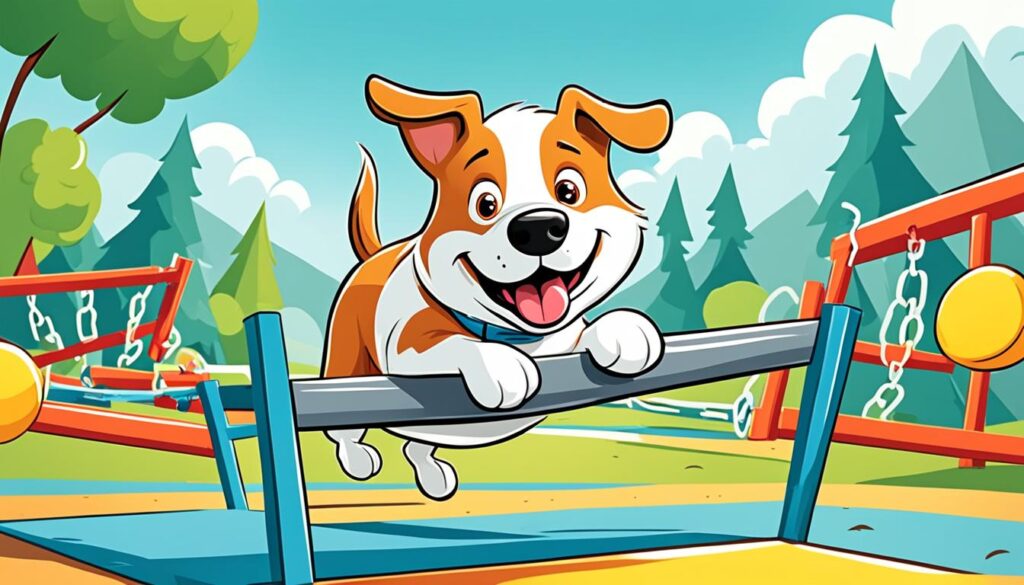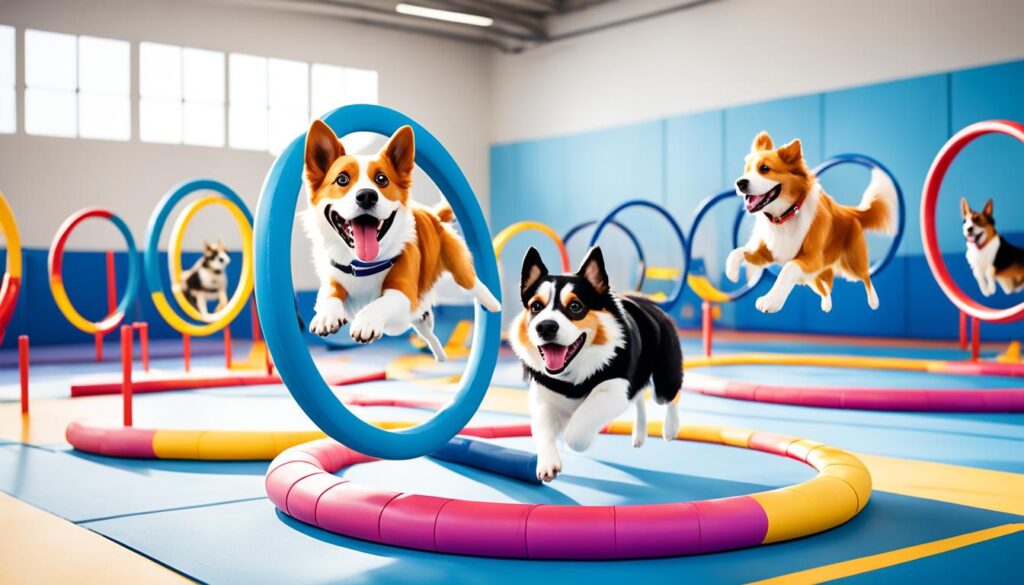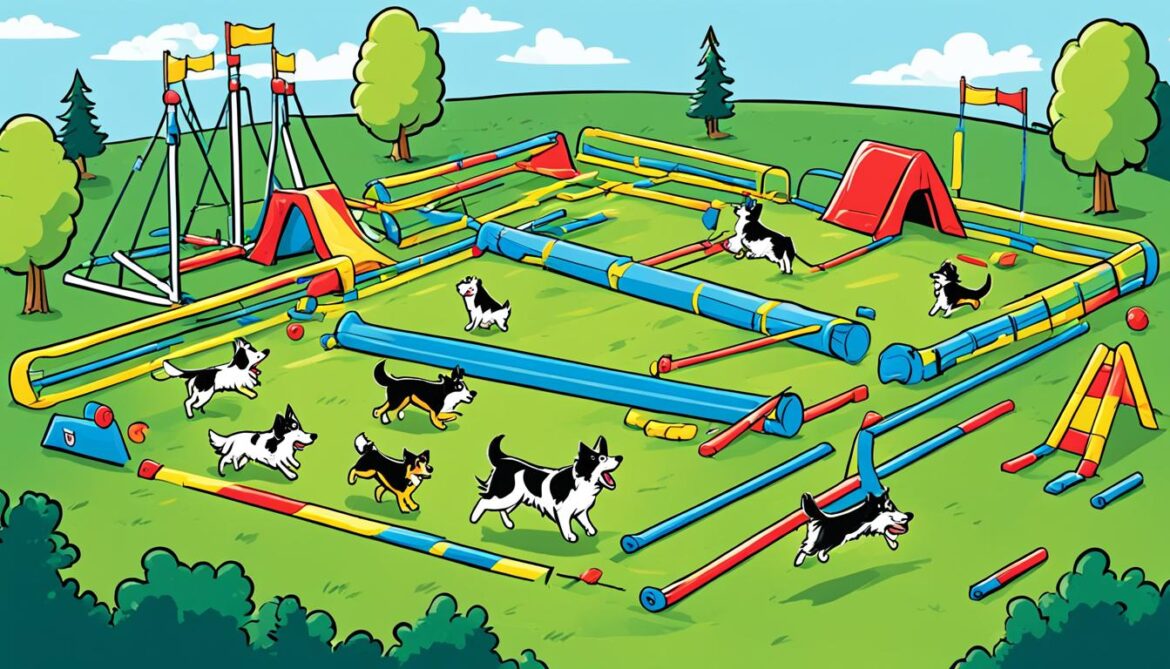Imagine the thrill of watching your furry friend gracefully maneuver through an obstacle course, their excitement palpable as they jump, weave, and conquer each challenge with precision and agility. It’s a sight that fills your heart with pride and admiration, knowing that your pup has not only developed incredible physical skills but also a strong bond with you. This is the power of dog agility training.
Whether you’re a seasoned dog owner or a new pup parent, dog agility training offers a multitude of benefits for both you and your four-legged companion. It’s a way to strengthen the bond between you, satisfy your dog’s natural instincts, and keep them mentally and physically fit. Plus, it’s incredibly fun!
But where do you start? How do you ensure that your dog receives the best training, using the right equipment, and achieving optimal results? That’s where we come in. In this article, we will guide you through the world of dog agility training, from its importance to finding the best classes and mastering obstacle courses, to enhancing your training with the right equipment.
Key Takeaways:
- Dog agility training is a fantastic way to strengthen the bond between you and your pup.
- It provides mental and physical stimulation for your dog, keeping them fit and happy.
- Finding the best dog agility classes and trainers is crucial for optimal results.
- Mastering the obstacle course takes time, patience, and the right training techniques.
- Enhance your training sessions with the right dog agility equipment for maximum effectiveness.
Why Agility Training for Dogs?
Agility training for dogs is more than just a fun activity. It offers a wide range of benefits that can greatly enhance your furry friend’s physical and mental well-being. From improving fitness levels to stimulating their mind, engaging in agility training can have a positive impact on your dog’s overall health and happiness.
Improved Fitness and Health
One of the key advantages of agility training for dogs is that it helps improve their fitness levels. Through various exercises and activities, such as jumps, tunnels, and weave poles, dogs engage in cardiovascular workouts that increase their endurance and stamina. Regular agility training can also help with weight management and reduce the risk of obesity, leading to a healthier and happier pup.
Mental Stimulation and Problem Solving
Agility training goes beyond physical exercise and offers mental stimulation for dogs. The challenging nature of navigating different obstacles requires focus, concentration, and problem-solving skills. As dogs learn to analyze the course and make split-second decisions, their cognitive abilities improve, keeping their minds sharp and engaged. This mental stimulation can also help alleviate boredom and destructive behaviors.
Bonding and Relationship Building
Engaging in agility training with your dog can strengthen the bond between you. Working together to tackle obstacles and navigate the course fosters trust, communication, and teamwork. Through positive reinforcement and reward-based training methods, you and your pup can develop a deeper understanding and connection, resulting in a more harmonious relationship.
Competitive Dog Agility
For those seeking an additional level of excitement, competitive dog agility is a popular sport that puts your dog’s skills to the test. Participating in agility trials not only allows your dog to showcase their abilities but also provides a platform for you to meet other dog enthusiasts and share in the joy of the sport. Competing in agility trials can be a thrilling experience that offers a sense of accomplishment and pride for both you and your furry companion.
“Agility training offers numerous benefits for dogs, including improved fitness, mental stimulation, and strengthened bonds with their owners.”

Finding the Best Dog Agility Classes
When it comes to dog agility training, finding the right classes for your furry friend is crucial for their success. Not all classes are created equal, so it’s important to do your research and find the best ones available.
Qualities of a Top Dog Agility Trainer
A top dog agility trainer possesses certain qualities that set them apart from the rest. Look for trainers who have:
- Extensive experience in dog agility training
- A deep understanding of canine behavior and learning techniques
- A positive, patient, and encouraging teaching style
- Excellent communication skills to guide both dogs and owners effectively
Remember, a great trainer will not only enhance your dog’s agility skills but also create a positive training experience for both of you.
Importance of a Positive Training Environment
A positive training environment is essential for your dog’s progress and well-being. Look for classes that prioritize:
- Positive reinforcement: Trainers who use rewards and praise to motivate and reinforce desired behaviors
- Small class sizes: Smaller groups allow for more personalized attention and better control during training sessions
- Safe and clean facilities: A clean and secure training area ensures the safety and comfort of your dog
Creating a positive training environment will make the learning process enjoyable and effective for both you and your furry companion.
Assessing Credibility and Expertise
Before enrolling in a dog agility class, it’s important to assess the credibility and expertise of the trainers and training facility. Consider the following:
- Check for certifications: Look for trainers who have obtained certifications from reputable organizations in the field of dog agility training.
- Read reviews and testimonials: Take the time to read reviews from previous clients to get an idea of their experiences and the effectiveness of the classes.
- Visit the facility: Schedule a visit to the training facility to see firsthand the quality of the equipment, cleanliness, and overall professionalism of the environment.
By conducting thorough research and assessment, you can ensure that you enroll your dog in the best dog agility classes available.

| Pros | Cons |
|---|---|
| Access to expert guidance and knowledge | May require a financial investment |
| Structured learning environment | May have limited class schedules |
| Opportunity to socialize your dog | Classes may be crowded |
| Chance to connect with like-minded dog owners | May be limited class availability in your area |
Mastering the Dog Obstacle Course
When it comes to dog agility training, mastering the obstacle course is a crucial aspect. In this section, we will explore the specifics of training your dog to navigate through obstacle courses, equipping you with the necessary knowledge and skills to help your pup succeed.
Obstacle courses are designed to challenge dogs physically and mentally, and they consist of various obstacles that require agility, speed, and focus. By training your dog to overcome these obstacles, you can enhance their physical fitness, mental stimulation, and obedience.
Types of Obstacles
Obstacle courses commonly feature a range of obstacles that test your dog’s abilities. Let’s take a look at some of the most common obstacles:
- Jumps: These obstacles involve your dog leaping over hurdles at varying heights. They improve your dog’s jumping skills and coordination.
- Tunnels: Tunnels require your dog to maneuver through narrow, enclosed spaces. This obstacle enhances your dog’s spatial awareness and confidence.
- Weave Poles: Weave poles challenge your dog to weave in and out of a series of upright poles. This obstacle sharpens your dog’s agility and coordination.
- A-Frames: A-Frames are inclined ramps that your dog must ascend and descend. They build your dog’s confidence and balance.
- Seesaws: Seesaws consist of a plank that pivots in the middle. Your dog needs to navigate across it while maintaining balance. This obstacle improves your dog’s coordination and control.
Training Techniques
Training your dog to excel in the obstacle course requires patience, consistency, and positive reinforcement. Here are some techniques to help you navigate the training process:
- Focus on Basic Commands: Before introducing your dog to the obstacles, ensure they have a strong foundation in basic commands such as sit, stay, and recall. This establishes a solid starting point for their agility training.
- Introduce One Obstacle at a Time: Start with a single obstacle and gradually introduce more as your dog becomes comfortable. This allows them to build confidence and understand each obstacle individually.
- Break it Down: If your dog is struggling with a particular obstacle, break it down into smaller steps. For example, if they struggle with weave poles, practice weaving through just a few poles at a time, gradually increasing the difficulty.
- Use Positive Reinforcement: Reward your dog with treats and praise when they successfully navigate an obstacle. Positive reinforcement reinforces their understanding and motivates them to continue progressing.
- Practice Regularly: Consistency is key in agility training. Set aside regular practice sessions to reinforce your dog’s skills and build their confidence.
Common Challenges
During the training process, you may encounter some challenges. It’s important to be aware of these challenges and approach them with patience and adaptability. Some common challenges include:
“My dog is hesitant to jump over hurdles.”
If your dog is hesitant with jumps, start with low hurdles and gradually increase the height as they become more comfortable. Use positive reinforcement and encourage them with praise and treats.
“My dog is having difficulty navigating the weave poles.”
If your dog struggles with the weave poles, practice slowly and break it down into smaller tasks. Use visual aids such as guides or targets to help them understand the weaving motion.
Enhance Your Training with Dog Agility Equipment
Take your dog agility training to the next level by incorporating the right equipment into your routine. The market offers various types of dog agility equipment that can help boost your pup’s skills and enhance their training sessions. From tunnels and jumps to weave poles and seesaws, each piece of equipment comes with specific benefits that contribute to your dog’s agility development.
One of the most popular and versatile pieces of equipment is the tunnel. It not only improves your dog’s confidence but also enhances their ability to navigate tight spaces. Whether you’re training for competition or just having fun, a tunnel can be an excellent addition to your obstacle course.
An important element in dog agility training is jumps. They help your dog develop their coordination, balance, and jumping skills. Adjustable jumps allow you to customize the height according to your dog’s size and ability, making it suitable for beginners and advanced agility enthusiasts.
If you’re focusing on improving your dog’s weaving skills, the weave poles are a must-have. These poles are spaced evenly, requiring your dog to weave in and out of them with precision and speed. As your dog becomes more proficient, you can increase the difficulty level by narrowing the spacing between the poles.
For dogs with an adventurous spirit, the seesaw is an exciting piece of equipment. It enhances your dog’s balance and confidence as they navigate the see-saw motion. Once your pup masters the seesaw, they’ll be ready to conquer more challenging obstacles on the course.
To give you a better understanding of the various types of dog agility equipment available, here’s a table summarizing the key features and benefits of each:
| Equipment | Benefits |
|---|---|
| Tunnel | Improves confidence, enhances navigating tight spaces |
| Jumps | Develops coordination, balance, and jumping skills |
| Weave Poles | Enhances weaving skills, improves speed and precision |
| Seesaw | Builds balance, boosts confidence |
By incorporating these equipment options into your dog agility training, you can create engaging and challenging exercises that contribute to your pup’s overall growth and development. Remember to always prioritize your dog’s safety and start with equipment suitable for their skill level. Over time, as your dog progresses, you can gradually introduce more complex challenges. So, equip yourself with the right gear, create an exciting training environment, and watch your dog’s agility skills flourish!
Conclusion
In conclusion, dog agility training is a fantastic way to boost your pup’s skills, increase their fitness and obedience, and forge a stronger bond with them. By following the tips and guidance provided in this article, you can find the best classes, master the obstacle course, and make the most of dog agility equipment.
Engaging in agility training not only provides physical exercise but also stimulates your dog mentally, preventing boredom and behavioral issues. The structured training sessions and obstacle course challenges help develop your dog’s problem-solving abilities and enhance their overall cognitive function.
Additionally, participating in competitive dog agility events can be a rewarding experience for both you and your furry friend. It provides an opportunity to showcase your dog’s skills, build confidence, and strengthen the bond between you as a team. The thrill of a successful run and the sense of accomplishment are unmatched.
So, what are you waiting for? Start your dog’s agility training journey today and witness their incredible progress. Whether you aim to compete or simply want to enjoy a fun and challenging activity with your dog, agility training is sure to bring joy and fulfillment to both of you.
